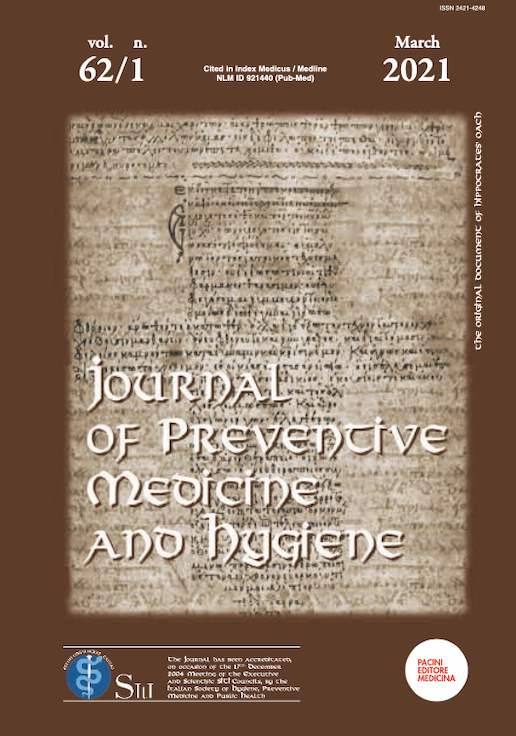Abstract
Introduction: As a fundamental dimension of quality, the patient safety and healthcare workers safety in the healthcare environment depend on the ability of each healthcare workers (whether administrators or technicians) to reduce the probability of error. This review focused on nursing students. The aim was to assess level and determinants of knowledge about risk assessment, risk prevention and risk management of nursing students.
Methods: A systematic review was performed according to the Preferred Reporting Items for Systematic Reviews and Meta-Analyses (PRISMA) statement. Two reviewers searched the bibliographic databases Pubmed, Scopus and Cinahl to collect all the available articles in English and Italian issued between 2015 and August 2019. To obtain an exhaustive string search, the following keywords were combined through Boolean operators AND and OR: Clinical Risk Assessment, Nursing Education, Nursing Student*, Patient Safety. The authors assessed the quality of the evidence by using the Grading of Recommendations, Assessment, Development and Evaluations (GRADE) method.
Results: Twelve papers are included. Although the literature on the nursing student's error is limited, their frequencies are worrying. Some authors have created a model of prevention of clinical error based on three level. However, the majority of nursing students don’t felt confident with a patient safety. Many authors shown that patient safety education was delivery by lecture, laboratory or simulation sessions.
Conclusions: This review underlines the need to revise the nursing curriculum on patient safety and the need to think what educational methodology is the better for the student to create a safe care.
References
2. Perrella G, Leggeri R. La gestione del rischio clinico. La sicurezza del paziente e la lotta agli sprechi nelle strutture pubbliche e private. FrancoAngeli, 2007.
3. Donaldson MS, Corrigan JM, Kohn LT. To err is human: building a safer health system. National Academies Press, 2000.
4. Ministero della Salute. Risk Management in Sanità-il problema degli errori. Commissione Tecnica sul Rischio Clinico DM, 5, 2003. Available at the link: http://www.salute.gov.it/imgs/c_17_pubblicazioni_583_allegato.pdf. Acced on 10 December 2019.
5. Chiari P, Mosci D, Naldi E. Evidence-based clinical practice: la pratica clinico-assistenziale basata su prove di efficacia. McGraw-Hill, 2011.
6. Stewart LA, Clarke M, Rovers M, Riley RD, Simmonds M, Stewart G, Tierney JF. Preferred reporting items for a systematic review and meta-analysis of individual participant data: the PRISMA-IPD statement. Jama, 2015, 313.16: 1657-1665.
7. Guyatt GH, Oxman AD, Vist GE, Kunz R, Falck-Ytter Y, Alonso-Coello P, Schunemann HJ. GRADE: an emerging consensus on rating quality of evidence and strength of recommendations. Bmj, 2008, 336.7650: 924-926.
8. Kirwan M, Riklikiene O, Gotlib J, Fuster P, Borta M. (2019).Regulation and current status of patient safety content in pre-registration nurse education in 27 countries: Findings from the Rationing-Missed nursing care (RANCARE) COST Action project. Nurse education in practice, 2019, 37: 132-140.
9. Stevanin S, Bressan V, Bulfone G, Zanini A, Dante A, Palese A. Knowledge and competence with patient safety as perceived by nursing students: The findings of a cross-sectional study. Nurse education today, 2015, 35.8: 926-93
10. Halperin O, Bronshtein O. The attitudes of nursing students and clinical instructors towards reporting irregular incidents in the medical clinic. Nurse education in practice, 2019, 36: 34-39.
11. Christensen L. Are clinical instructors preventing or provoking adverse events involving students: A contemporary issue. Nurse education today, 2018, 70: 121
12. Kim YM, Yoon YS, Hong HC, Min A. Effects of a patient safety course using a flipped classroom approach among undergraduate nursing students: A quasi-experimental study. Nurse education today, 2019
13. Alquwez N, Cruz JP, Alshammari F, Felemban EM, Almazan JU, Tumala RB, Tork HM. A multi‐university assessment of patient safety competence during clinical training among baccalaureate nursing students: A cross‐sectional study. Journal of clinical nursing, 2019, 28.9-10: 1771-1781.
14. Usher K, Woods C, Parmenter G, Hutchinson M, Mannix J, Power T, Jackson D.Self-reported confidence in patient safety knowledge among Australian undergraduate nursing students: a multi-site cross-sectional survey study. International journal of nursing studies, 2017, 71: 89-96.
15. Mbuthia NN, Moleki MM. Preregistration nursing students’ perceived confidence in learning about patient safety in selected Kenyan universities. Curationis, 2019, 42.1.
16. Lee NJ, Jang H, Park SY. Patient safety education and baccalaureate nursing students' patient safety competency: A cross‐sectional study. Nursing & health sciences, 2016, 18.2: 163-171
17. Palese A, Gonella S, Brugnolli A, Mansutti I, Saiani L, Terzoni S. Nursing students' interprofessional educational experiences in the clinical context: findings from an Italian cross-sectional study. BMJ open, 2019, 9(3): e025575. doi:10.1136/bmjopen-2018-025575
18. Stomski N, Gluyas H, Andrus P, Williams A, Hopkins M, Walters J, Morrison P. The influence of situation awareness training on nurses' confidence about patient safety skills: A prospective cohort study. Nurse education today, 2018, 63: 24-28
19. Fukuta D, Iitsuka M. Nontechnical skills training and patient safety in undergraduate nursing education: a systematic review. Teaching and Learning in Nursing, 2018, 13(4): 233-239.

